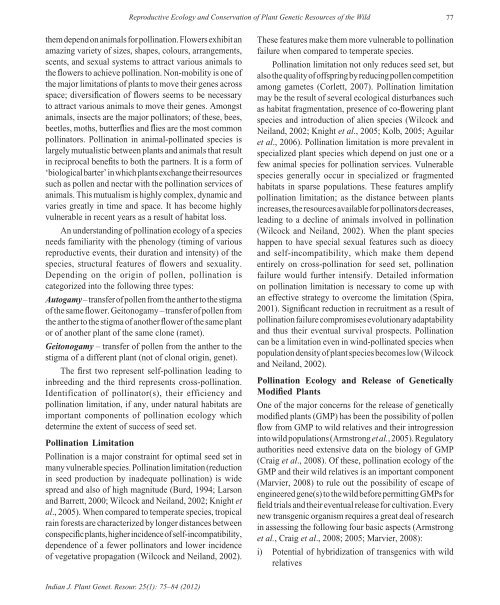indian society of plant genetic resources - Bioversity International
indian society of plant genetic resources - Bioversity International
indian society of plant genetic resources - Bioversity International
You also want an ePaper? Increase the reach of your titles
YUMPU automatically turns print PDFs into web optimized ePapers that Google loves.
Indian J. Plant Genet. Resour. 25(1): 75–84 (2012)<br />
Reproductive Ecology and Conservation <strong>of</strong> Plant Genetic Resources <strong>of</strong> the Wild 77<br />
them depend on animals for pollination. Flowers exhibit an<br />
amazing variety <strong>of</strong> sizes, shapes, colours, arrangements,<br />
scents, and sexual systems to attract various animals to<br />
the fl owers to achieve pollination. Non-mobility is one <strong>of</strong><br />
the major limitations <strong>of</strong> <strong>plant</strong>s to move their genes across<br />
space; diversifi cation <strong>of</strong> fl owers seems to be necessary<br />
to attract various animals to move their genes. Amongst<br />
animals, insects are the major pollinators; <strong>of</strong> these, bees,<br />
beetles, moths, butterfl ies and fl ies are the most common<br />
pollinators. Pollination in animal-pollinated species is<br />
largely mutualistic between <strong>plant</strong>s and animals that result<br />
in reciprocal benefi ts to both the partners. It is a form <strong>of</strong><br />
‘biological barter’ in which <strong>plant</strong>s exchange their <strong>resources</strong><br />
such as pollen and nectar with the pollination services <strong>of</strong><br />
animals. This mutualism is highly complex, dynamic and<br />
varies greatly in time and space. It has become highly<br />
vulnerable in recent years as a result <strong>of</strong> habitat loss.<br />
An understanding <strong>of</strong> pollination ecology <strong>of</strong> a species<br />
needs familiarity with the phenology (timing <strong>of</strong> various<br />
reproductive events, their duration and intensity) <strong>of</strong> the<br />
species, structural features <strong>of</strong> fl owers and sexuality.<br />
Depending on the origin <strong>of</strong> pollen, pollination is<br />
categorized into the following three types:<br />
Autogamy – transfer <strong>of</strong> pollen from the anther to the stigma<br />
<strong>of</strong> the same fl ower. Geitonogamy – transfer <strong>of</strong> pollen from<br />
the anther to the stigma <strong>of</strong> another fl ower <strong>of</strong> the same <strong>plant</strong><br />
or <strong>of</strong> another <strong>plant</strong> <strong>of</strong> the same clone (ramet).<br />
Geitonogamy – transfer <strong>of</strong> pollen from the anther to the<br />
stigma <strong>of</strong> a different <strong>plant</strong> (not <strong>of</strong> clonal origin, genet).<br />
The fi rst two represent self-pollination leading to<br />
inbreeding and the third represents cross-pollination.<br />
Identification <strong>of</strong> pollinator(s), their efficiency and<br />
pollination limitation, if any, under natural habitats are<br />
important components <strong>of</strong> pollination ecology which<br />
determine the extent <strong>of</strong> success <strong>of</strong> seed set.<br />
Pollination Limitation<br />
Pollination is a major constraint for optimal seed set in<br />
many vulnerable species. Pollination limitation (reduction<br />
in seed production by inadequate pollination) is wide<br />
spread and also <strong>of</strong> high magnitude (Burd, 1994; Larson<br />
and Barrett, 2000; Wilcock and Neiland, 2002; Knight et<br />
al., 2005). When compared to temperate species, tropical<br />
rain forests are characterized by longer distances between<br />
conspecifi c <strong>plant</strong>s, higher incidence <strong>of</strong> self-incompatibility,<br />
dependence <strong>of</strong> a fewer pollinators and lower incidence<br />
<strong>of</strong> vegetative propagation (Wilcock and Neiland, 2002).<br />
These features make them more vulnerable to pollination<br />
failure when compared to temperate species.<br />
Pollination limitation not only reduces seed set, but<br />
also the quality <strong>of</strong> <strong>of</strong>fspring by reducing pollen competition<br />
among gametes (Corlett, 2007). Pollination limitation<br />
may be the result <strong>of</strong> several ecological disturbances such<br />
as habitat fragmentation, presence <strong>of</strong> co-fl owering <strong>plant</strong><br />
species and introduction <strong>of</strong> alien species (Wilcock and<br />
Neiland, 2002; Knight et al., 2005; Kolb, 2005; Aguilar<br />
et al., 2006). Pollination limitation is more prevalent in<br />
specialized <strong>plant</strong> species which depend on just one or a<br />
few animal species for pollination services. Vulnerable<br />
species generally occur in specialized or fragmented<br />
habitats in sparse populations. These features amplify<br />
pollination limitation; as the distance between <strong>plant</strong>s<br />
increases, the <strong>resources</strong> available for pollinators decreases,<br />
leading to a decline <strong>of</strong> animals involved in pollination<br />
(Wilcock and Neiland, 2002). When the <strong>plant</strong> species<br />
happen to have special sexual features such as dioecy<br />
and self-incompatibility, which make them depend<br />
entirely on cross-pollination for seed set, pollination<br />
failure would further intensify. Detailed information<br />
on pollination limitation is necessary to come up with<br />
an effective strategy to overcome the limitation (Spira,<br />
2001). Signifi cant reduction in recruitment as a result <strong>of</strong><br />
pollination failure compromises evolutionary adaptability<br />
and thus their eventual survival prospects. Pollination<br />
can be a limitation even in wind-pollinated species when<br />
population density <strong>of</strong> <strong>plant</strong> species becomes low (Wilcock<br />
and Neiland, 2002).<br />
Pollination Ecology and Release <strong>of</strong> Genetically<br />
Modifi ed Plants<br />
One <strong>of</strong> the major concerns for the release <strong>of</strong> <strong>genetic</strong>ally<br />
modifi ed <strong>plant</strong>s (GMP) has been the possibility <strong>of</strong> pollen<br />
fl ow from GMP to wild relatives and their introgression<br />
into wild populations (Armstrong et al., 2005). Regulatory<br />
authorities need extensive data on the biology <strong>of</strong> GMP<br />
(Craig et al., 2008). Of these, pollination ecology <strong>of</strong> the<br />
GMP and their wild relatives is an important component<br />
(Marvier, 2008) to rule out the possibility <strong>of</strong> escape <strong>of</strong><br />
engineered gene(s) to the wild before permitting GMPs for<br />
fi eld trials and their eventual release for cultivation. Every<br />
new transgenic organism requires a great deal <strong>of</strong> research<br />
in assessing the following four basic aspects (Armstrong<br />
et al., Craig et al., 2008; 2005; Marvier, 2008):<br />
i) Potential <strong>of</strong> hybridization <strong>of</strong> transgenics with wild<br />
relatives

















